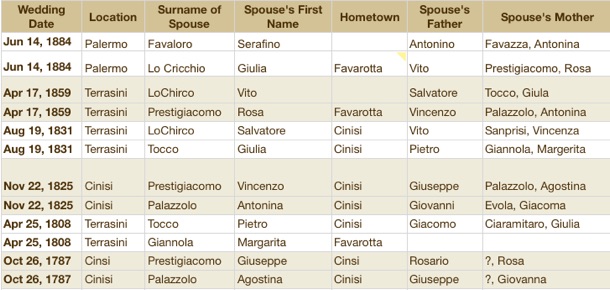My Great-grandmother Favaloro


Julia was sent to work with an aunt in one of the “palaces of Palermo” first as a caregiver to the young children, and later as a ladies’ maid. There, Julia became quite skilled with a needle. She tatted lace, learned cutwork, crocheted and knitted. There was nothing she couldn’t sew, even men’s suits. She earned an income with her needle her entire life, sometimes receiving jewelry or other goods in payment.
An intelligent and curious young woman, Julia learned about manners and proper behavior during her years in the palace. Lessons she took pains to pass along to her children. The families’ artistic talent and excellent memory are also traceable to Julia.
Julia would not only host her grandchildren two or three at a time in her Fort Square home for fortnight holidays, she would also take extended three month long visits to her daughter Antonia’s home in Boston. Julia spent the last few years of her life with her youngest daughter, Ann, and her husband, Leo Linquata, surrounded by her children, grandchildren and great-grandchildren from whom she took great delight and who adored her. She continued to sew for all her forty grandchildren and sixteen great-grandchildren right up until her death.
A very holy and prayerful woman, Julia was devoted to St. Joseph. When she died, Julia sat up in bed, arms outstretched and greeted Saint Joseph who she saw standing at the foot of her bed.
Read more about Julia in her grand-daughter’s story “My Grandmother’s Apron”.
What you should know
Name:
Giulia LoChirco
Alt. Spellings: LoCricchio, LoChrico
BAPTIZED:
April 13, 1862 in Terrasini, Sicily
Died:
Jan 17, 1941 in Gloucester, MA
Married:
Serafino Favaloro 4/3/1862 - 8/3/1946
June 14, 1884 in Palermo, Sicily
Alt. Spellings: Favalora
Parents:
Rosa Prestigiacomo 7/19/1840 - 1/29/1876
Vito LoChirco 1832 - 3/1/1874
Married : April 17, 1859
Siblings:
Salvatore m. Maria Fronteri
Vincenzo m Maria Russo
‘Nina - Sr. Maria Girolama
paternal grandParents:
Salvatore LoChirco
Giulia Tocco *
Married: August 19, 1831
maternal grandParents:
Vincenzo Prestigiacomo
Antonina Palazzolo
Married: Nov 22, 1825, Cinsi, Sicily
Sicilian Historical novels:
Sicilian Documentaries:

about Julia
Maria Santissima delle Grazie (Terrasini, Palermo) 1736-1910
Santa Fara Vergine (Cinisi, Palermo) 1672 -1934

-
-
* Footnote on the Tocco Family:
-
Agiographers from the XVII century wrote that the Toccos were direct descendants of King Totila, king of the Ostrogoths from 541 until his death 1 July 552. He waged the Gothic War against the Byzantine Empire for the mastery of Italy and Sicily. However, most researchers say Toccos were Longobards established in the Duchy of Benevento, Southern Lombardia during the Middle Ages. This version seems to be the more probable, as Carlo Tocco, biographer of Saint Thomas Aquinas, wrote about the Longobard Jurisprudence. The Tocco name was the Italianized Germanic Toch. It may have also have originated in or migrated through Greece as Toka.
-
-
-
A political family, there is a Ugolino Tocco, Mayor of Naples 1195, and a Maria Tocco who married the last Byzantine emperor of Constantinople, Constantine XI, in 1428. The Toccos from the province of Palermo have the same ancestry as Leonard III, Prince of Arta in northwestern Greece. A crusader who fought the Turks on behalf of the Pope during the era of Prince Vlad the Impaler, Leonard III Tocco was a relation of Eleonora Tocco Manriquez (1495-1558) princess of Carini, wife of Pietruccio La Grua Talamanca, Baron of Carini. The ancient Palazzo Tocco is located next to the Castle La Grua in Carini. Carini, originally called Ikar, was founded by the Greek inventor Daedalus, the father of Icarus who flew too close to the sun.
-
-
-
Possessing the most fertile land in the territory, the Toccos may have been involved in a major feud with the Benedictine Friars of Cinisi. The fresh water spring called the Favarotta (Arab little fountain, al-fawara), which provided water to the first Palazzo La Grua, and the fishermen’s village of Favarotta were also on Tocco territory. The village is located on the promontory Ciucca, close to the natural port at the mouth of the torrent.
-
(Source, Agostino Tocco of Sicily)
Click here for a 19th century true story about another Principessa di Carini.
Web Design by Karen Spencer
Copyright 2009 - 2018